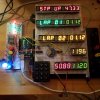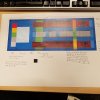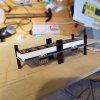JakeConhale
New Member
My next project is a wall clock recreation of the time circuits from back to the future as a wall clock, designed to both be aesthetically pleasing and functional.
Part of this is admittedly inspired by the post on the adafruit website: https://blog.adafruit.com/2012/07/0...spired-time-circuit-clock-with-adafruit-gear/
as well as by another person's pet project: http://www.partsnotincluded.com/projects/time-circuits/
That second site is worth a read, the author goes into lovely detail reverse engineering the original design and how he goes about his own recreation.
While I'm inspired by both, this is ultimately my own design. Not entirely sure how I'm going to make the exterior, but I anticipate spending more time on the circuitry and programming for now.
First entry: functionality.
I plan on including the following functions in my wall clock, presented roughly in order of priority/desireability:
The LED color select refers to how the actual prop differed from what was desired.

You can see that the DEST AM/PM and colon lights are yellow rather than red. In the film, one can attribute that to Doc Brown simply not having the parts on hand.
All this will be controlled by an Arduino Uno and hopefully I'm not going to overload the board! My layout won't be perfect, but that's life.
Part of this is admittedly inspired by the post on the adafruit website: https://blog.adafruit.com/2012/07/0...spired-time-circuit-clock-with-adafruit-gear/
as well as by another person's pet project: http://www.partsnotincluded.com/projects/time-circuits/
That second site is worth a read, the author goes into lovely detail reverse engineering the original design and how he goes about his own recreation.
While I'm inspired by both, this is ultimately my own design. Not entirely sure how I'm going to make the exterior, but I anticipate spending more time on the circuitry and programming for now.
First entry: functionality.
I plan on including the following functions in my wall clock, presented roughly in order of priority/desireability:
- Current (CURR) time with battery backup, accomodating leap years
- Ability to manually set Destination (DEST) time as in the movie, as well as the Last Time Departed (PAST) time
- Controllable brightness
- 12/24hr mode select
- DST mode select
- LED color select
- Secondary timezone - can select either PAST or DEST time field for display.
- Stop watch, both count up and count down functions
- Stop watch lap feature
- Alarm clock
The LED color select refers to how the actual prop differed from what was desired.

You can see that the DEST AM/PM and colon lights are yellow rather than red. In the film, one can attribute that to Doc Brown simply not having the parts on hand.
All this will be controlled by an Arduino Uno and hopefully I'm not going to overload the board! My layout won't be perfect, but that's life.























